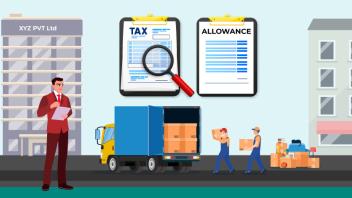GST on Transportation of Household goods - Packers and Movers GST Rate

At the time of shifting your household goods from one place to another, along with all other necessities, you should also understand the basics of the Goods and Services Tax process. Being aware of the tax process will make you understand how much total tax needs to be paid for the service. This will help you to prepare a budget for your move. It is very important to understand the details of GST when it comes to transporting things, especially household items. The GST charge on household goods transportation for different transport modes is 5% of the total service charge. In this blog we will talk about the Goods Transport Agency (GTA), waybills, and consignment notes, as well as other complicated parts of GST that have to do with moving household things.

What is GST?
GST stands for Goods and Services Tax. When GST was introduced in India on July 1, 2017, it replaced a number of indirect taxes, such as VAT, service tax, excise duty, and a number of state-level taxes. This made the Indian tax system simpler.
Purpose of GST on Household Goods Transportation
The implementation of GST on household goods transportation has several objectives:
-
Streamlining Taxation: Before GST, the transportation industry, which included movers of household goods, had to deal with a number of different state and national taxes. This often caused taxes to "cascade," meaning that more taxes were paid on top of taxes that had already been paid. This made costs go up. With GST, a lot of these taxes were rolled into one single tax, which made the tax system simpler and easier to understand.
-
Ensuring Uniformity: All of India's states now have the same tax system thanks to GST. This is especially important for moving household things between states, which happens a lot. Transporters, like packers and movers, no longer have to deal with the different tax systems that each state has.
-
Enhancing Transparency: GST added tools like the e-waybill to keep track of how things move and make sure taxes are paid correctly. For moving home goods, this means stricter rules to make sure services follow the rules and customers aren't taken advantage of.
-
Cost Efficiency: GST aims to lower the cost of services, like transporting household goods, for end users by preventing the "cascading effect" of taxes and making sure that the tax is only applied to the value added at each stage.
It is very important to understand GST in terms of transporting home goods. Being aware of why and how much tax is paid not only helps you make smart choices, but it also keeps you from taking part in illegal or tax-avoiding activities without knowing it.
Does Packing Charges Attract GST?
-
The service of packing household goods is seen as a value-added service provided by packers and movers.
-
As a result, packing services, when provided in conjunction with transportation services, are typically not treated as separate services but as an integral part of the transportation service.
-
Thus, the charges levied for packing are usually included in the overall charge for transportation services, and GST is applied on the aggregate amount which is 5%.
What is GTA (Goods Transport Agency)?
'GTA' is a term that is often used when talking about transportation of goods in India. But what does it really mean, and how is it different from other transportation options? Let's learn everything we can about the Goods Transport Agency.
Definition and Role of GTA in Transportation of goods
Goods Transport Agency (GTA) refers to any person or entity that provides services in relation to the transport of goods by road and issues a consignment note. The consignment note is a proof of the contract between the sender and the GTA for the transportation of goods.
Difference between a Regular Transporter and a GTA
The difference between a GTA and a regular transporter is primarily based on the issuance of a consignment note and the nature of services offered such as:
-
Consignment Note: A GTA provides a consignment note to the customers. This note lists the items being shipped, where they are going, and who is sending them. A regular transporter might not necessarily provide such a document.
-
Service Offering: While both GTAs and regular transporters move goods, GTAs offer a more comprehensive set of services. This includes responsibilities like packing, loading, transporting, unloading, and even unpacking in some cases. On the other hand, a regular transporter might only offer the service of moving the goods from point A to B.
-
Liability: As soon as the consignment note is issued, the GTA is responsible for the goods while they are in transit and can be held responsible for any damage. The amount of responsibility might not be the same for a regular transporter unless it is made clear in the agreement.
Anyone engaged in the transport of goods needs to understand the idea of GTA, whether they are a service provider or a customer. It makes sure that processes, taxes, and rules are clear.
GST Rate for Services Provided by GTA
As of the last update, the GST rate applicable for services provided by GTAs is 5%. However, it's crucial to note that if this rate is chosen, then the GTA service provider cannot avail Input Tax Credit (ITC) on the goods and services used to provide the said service. The other option is for GTAs to choose a 12% GST rate, which lets them claim ITC. The GTA gives you a choice, but the 5% rate with no ITC claim is the most usual choice because its easy.
Reverse Charge Mechanism (RCM) and its Application on GTA Services
What makes the GST system special is the Reverse Charge Mechanism (RCM). This is how the person who receives goods or services becomes responsible for paying tax, instead of the person who provides them. In the context of GTA:
-
Services provided by a GTA to a registered person are typically subject to RCM. This means that the recipient of the service (i.e., the person or entity hiring the GTA) is responsible for paying the GST directly to the government, rather than the GTA charging and depositing it.
-
However, if the recipient is an unregistered individual or entity, then the GTA would charge the GST, and the responsibility shifts back to the GTA to deposit it with the government.
Exemptions
Certain services provided by GTAs enjoy exemptions from GST, which include:
-
Transportation of agricultural produce.
-
Goods where the total consignment value of such goods is less than ₹1,500.
-
Transportation of milk, salt, and food grains, including flours, pulses, and rice.
-
Transportation of organic manure.
-
Transportation of newspaper or magazines registered with the Registrar of Newspapers.
-
Transportation of relief materials for disaster, calamities, accidents, or mishaps.
-
Passengers accompanying the goods.
-
Transportation of goods from the port, airport, air cargo complex, or land customs station to an inland container depot (ICD) or a container freight station (CFS) for clearance by Customs.
What is a Waybill?
Someone who transports goods, like a trucking company, a train company, or an airline, issues a waybill. This paper has information about the shipment of goods and the person who will be getting the shipment. Usually, a waybill goes with the things being shipped, no matter what kind of shipping it is. It has more than one use:
-
Proof of Receipt: It acts as a receipt of goods by the transport service provider, confirming that they have received the goods and are obligated to deliver them to the designated location.
-
Details of Goods: The waybill provides crucial details about the shipment, such as the nature, quantity, and destination of goods, which aids in efficient handling and delivery.
-
Contract of Carriage: While it's not a legal contract, the waybill signifies the carrier's commitment to transport the goods to the mentioned destination while maintaining their condition.
Mandatory Requirements and When is it Needed
Waybills, especially the e-waybill, are mandatory under certain conditions:
-
Value Threshold: For any goods shipment having a value exceeding ₹50,000, an e-waybill is required.
-
Inter-State Movement: Any movement of goods, regardless of value, from one state to another necessitates an e-waybill.
-
Mandatory Even for Registered Persons: Even if you are a registered person under GST, if you're transporting goods as part of a supply or due to reasons other than supply (like returns), an e-waybill becomes essential.
-
By Specific Carriers: Air and sea shipments always require an AWB or BOL, respectively, irrespective of the value of goods.
Understanding waybills and their importance is crucial for anyone involved in the shipment of goods. It ensures compliance, smoother operations, and also serves as a protection against disputes related to the transportation and receipt of goods.
What is a Consignment Note?
A consignment note is a standard-format document issued by a transporter (often a trucking or shipping company) that serves as evidence of a contract of carriage between the sender and the carrier. It confirms that the carrier has received the goods mentioned in the note in an acceptable condition, with an agreement to transport them to a specified location for delivery.
While the format can vary, a typical consignment note contains the following essential details:
-
Consignment Number
-
Carrier Details
-
Description of Goods
-
Terms of Carriage
-
Freight Details
-
Delivery Instructions
How Consignment Note is Related to GST
When talking about the Goods Transport Agency (GTA), the link between a consignment note and GST is especially important. Under the GST system:
-
Only those transporters who issue a consignment note are considered as a Goods Transport Agency (GTA).
-
GST is charged on services offered by a GTA. Since there is a consignment note, it means that the service is a GTA service and accordingly, GST applies.
-
The consignment note essentially becomes proof that the services are rendered by a GTA, making it a document of significance from GST perspective.
A consignment note is a piece of paper that makes sure that the transportation of things is clear, legal, and organised. Anyone involved in this field needs to know all of its details, especially when it comes to GST.
GST on Household Goods for Different Transport Modes
India has many ways to move household goods from one place to another, including by road, train, air, or water. The Goods and Services Tax (GST) system, on the other hand, hits each of these lines in a different way.
GST on Road Transportation Household Goods
Household goods moved via road are predominantly under the purview of Goods Transport Agency (GTA) services, especially when packers and movers are involved.
-
GST Rate: As discussed earlier, the typical GST rate applied for GTA services is 5% under the Reverse Charge Mechanism (RCM). If the GTA opts to claim the Input Tax Credit, the rate stands at 12%.
-
Exemptions: Certain goods, when transported, such as agricultural produce or if the consignment value is less than ₹1,500, can avail of GST exemptions.
GST on Train Transportation Household Goods
Railways are a popular mode for bulk transportation. When it comes to moving household goods.
-
GST Rate: The services of transporting goods by rail attract a GST rate of 5% with Input Tax Credit (ITC) on input services and 12% with ITC on both input services and goods.
-
Exemptions: Transportation of agricultural produce, milk, salt, and food grains including flours, pulses, and rice by railways is exempt from GST.
GST on Air Transportation of Household Goods
Though not the most common, air transport is chosen for rapid transit or international relocation.
-
GST Rate: Transportation of household goods by air attracts a GST of 5% with ITC only on input services and 12% with ITC on both goods and input services. For international shipments, the tax might vary based on the destination and nature of goods.
-
Exemptions: Transportation of agricultural produce and goods intended for international shipment from or to India are exempted from GST.
GST on Ship Transportation of Household Goods
Waterways are commonly used for coastal relocations and international moves.
-
GST Rate: The transportation of goods by vessel attracts a 5% GST with ITC on input services alone.
-
Exemptions: Goods meant for international transport, either imports or exports, are exempted from GST when moved via waterways.
When picking the best way to move household goods, you need to think about the costs, ease of use, time, and GST effects. Knowing how taxes work for each way makes things clear, helps you plan your finances better, and makes sure you follow India's tax rules.
GST has revolutionized all industries, specially transportation. Understanding GST isn't just about paying taxes; it's about ensuring seamless and fast shipping. Each GST document, rate, and provision is crucial for easy transport. This comprises consignment notes and waybills.
But knowledge isn't enough. Active obedience ensures a pleasant ride. This protects carriers from legal issues and fines while providing clear, fast, and efficient service to customers.
Now that we have easy access to information, following the regulations and staying up-to-date indicates that you're committed to doing your best, being professional, and respecting the system. GST should guide us on transportation methods and byways. We'll travel with compliance, understanding, and efficiency.











